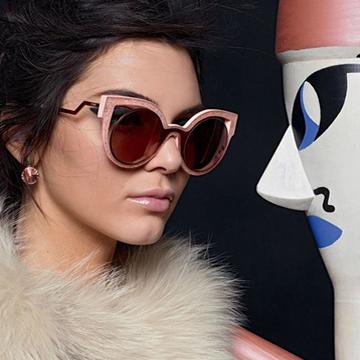Sunglasses - Frequently Asked Questions
Popular
How to properly clean sunglasses?
Cleaning your sunglasses regularly helps maintain their clarity and prolongs their lifespan. Here's a simple step-by-step guide on how to clean your sunglasses effectively:
Gather Supplies: You'll need a few supplies to clean your sunglasses:
- Microfiber cloth or lint-free cloth
- Mild soap (dish soap or hand soap)
- Warm water
- Optional: Lens cleaner solution or lens wipes
Rinse Lenses: Start by rinsing your sunglasses under lukewarm tap water to remove any dust, dirt, or debris from the lenses.
Apply Soap: Place a small drop of mild soap on your fingertips or directly onto the lenses. Avoid using harsh or abrasive cleaners, as they can damage lens coatings.
Gently Clean Lenses: Use your fingertips to gently rub the soap over the entire surface of each lens, including the front and back. Pay attention to any areas with stubborn spots or fingerprints.
Rinse Again: Rinse the lenses thoroughly under lukewarm water to remove the soap residue. Ensure that all soap is rinsed off to prevent streaks or smudges.
Dry Lenses: Use a clean, dry microfiber cloth or lint-free cloth to gently pat the lenses dry. Avoid rubbing the lenses vigorously, as this can cause scratches or damage.
Polish Lenses (Optional): If desired, you can use a lens cleaner solution or lens wipes to give your sunglasses a final polish. Spray a small amount of cleaner onto the lenses and wipe them clean with a microfiber cloth.
Clean Frames: Don't forget to clean the frames and nose pads of your sunglasses as well. Use a damp cloth or cotton swab to wipe away any dirt or residue.
Store Properly: After cleaning, store your sunglasses in a protective case to prevent scratches and damage when not in use.
Regular Maintenance: Make it a habit to clean your sunglasses regularly, especially if you wear them frequently or in dusty or dirty environments. Cleaning them regularly will help keep them looking their best and ensure optimal visibility.
By following these simple steps, you can keep your sunglasses clean and clear, allowing you to enjoy clear vision and UV protection whenever you wear them.
Are sunglasses good or bad for the eyes?
Sunglasses, when chosen correctly, can actually be beneficial for your eyes by providing protection against harmful ultraviolet (UV) radiation from the sun. Prolonged exposure to UV rays can lead to various eye health issues, including cataracts, macular degeneration, and photokeratitis (sunburn of the cornea). Wearing sunglasses with proper UV protection can help reduce the risk of these conditions.
However, not all sunglasses offer adequate UV protection, and wearing sunglasses with poor-quality lenses or without UV protection can potentially be harmful to your eyes. When shopping for sunglasses, it's important to look for pairs that provide 100% UV protection or block at least 99% of UVA and UVB rays.
In addition to UV protection, sunglasses can also shield the eyes from glare and bright sunlight, reducing squinting and eye strain. This can be especially beneficial for individuals who spend a lot of time outdoors, such as during sports activities or while driving.
On the other hand, wearing sunglasses with very dark lenses in low-light conditions can impair vision and make it difficult to see clearly. It's important to choose sunglasses with appropriate lens tint and brightness for the given lighting conditions to maintain optimal vision and safety.
Overall, wearing sunglasses with proper UV protection and appropriate lens tint can help protect your eyes from sun-related damage and improve comfort and visual clarity outdoors.
Check out our Fashion Forward article for more information.
Are sunglasses FSA eligible?
Generally, non-prescription sunglasses are not eligible for reimbursement through a Flexible Spending Account (FSA) or Health Savings Account (HSA) because they are considered a cosmetic or personal use item rather than a medical necessity. However, prescription sunglasses prescribed by a qualified eye care professional for vision correction or medical reasons are typically eligible for reimbursement. It's important to keep in mind that FSA and HSA rules may vary, so it's always a good idea to check with your plan administrator or review your plan documents for specific eligibility criteria.
Can I wear my sunglasses to view a solar eclipse?
Regular sunglasses are not safe for viewing a solar eclipse. Viewing a solar eclipse, whether partial or total, without proper eye protection can cause serious eye damage or even permanent blindness. Regular sunglasses do not provide sufficient protection against the intense solar radiation emitted during an eclipse.
To safely view a solar eclipse, you should use special-purpose solar filters or eclipse glasses that meet the international standard for eye safety (ISO 12312-2). These glasses are designed specifically for solar viewing and block out harmful ultraviolet, visible, and infrared radiation. They should be labeled as "ISO 12312-2 compliant" to ensure they meet safety standards.
Additionally, other safe methods for viewing a solar eclipse include using a solar viewer or projection method, such as a pinhole projector or solar telescope, to indirectly view the eclipse without looking directly at the sun.
Remember to never look directly at the sun without proper eye protection, even during an eclipse. Serious eye injury can occur within seconds without adequate protection.
Can sunglasses prevent cataracts?
Yes, wearing sunglasses with proper UV protection can potentially help prevent cataracts. Cataracts are a common age-related eye condition characterized by clouding of the lens inside the eye, which can lead to vision impairment and blindness if left untreated. While there are various factors that contribute to the development of cataracts, exposure to ultraviolet (UV) radiation from the sun is a known risk factor.
Prolonged exposure to UV radiation without adequate eye protection can accelerate the development of cataracts and increase the risk of developing them earlier in life. UV radiation can cause oxidative damage to the proteins in the lens of the eye, leading to the formation of cataracts over time.
By wearing sunglasses that provide 100% UV protection or block at least 99% of UVA and UVB rays, you can help reduce your exposure to harmful UV radiation and potentially lower your risk of developing cataracts. This is especially important during peak sunlight hours and in environments with high levels of UV radiation, such as at the beach or in snowy conditions where sunlight is reflected off surfaces.
It's important to choose sunglasses that offer adequate UV protection and wear them consistently whenever you're outdoors, even on cloudy days when UV rays can still penetrate cloud cover. Additionally, wearing a wide-brimmed hat and seeking shade when possible can provide added protection for your eyes against UV radiation and reduce the risk of developing cataracts and other UV-related eye conditions.
Styles
What are the common styles and shapes of sunglasses?
Here's a list of some common styles and shapes of sunglasses:
Aviator: Characterized by their teardrop-shaped lenses and thin metal frames.
Wayfarer: Known for their trapezoidal frames and distinctively thick arms.
Round: Circular lenses with minimal frames, popularized by John Lennon.
Cat-eye: Features upswept outer edges, resembling the shape of a cat's eye.
Clubmaster: Combines elements of both browline and wayfarer styles, with thicker upper frames and thinner lower rims.
Square: Square-shaped frames with straight edges, offering a bold and modern look.
Oval: Soft, rounded frames that complement a variety of face shapes.
Rectangle: Angular frames with straight lines, suitable for adding structure to rounder faces.
Shield: Single, wrap-around lens design, offering maximum coverage and protection.
Browline: Features a thicker upper frame, resembling eyebrows, and thinner rims on the bottom.
Sport: Designed for active lifestyles, typically featuring wrap-around frames and impact-resistant lenses.
Oversized: Larger than standard frames, providing extra coverage and a fashion-forward statement.
Rimless: Lenses are attached directly to the temples without any frames around them, offering a minimalist look.
Butterfly: Similar to cat-eye frames but with more exaggerated upswept angles, resembling butterfly wings.
Semi-rimless: Frames that only partially encircle the lenses, offering a lightweight and modern aesthetic.
These are just some of the many styles and shapes of sunglasses available, each offering its own unique blend of fashion, functionality, and protection.
What are some of the uncommon sunglasses styles and shapes?
Here are some less common styles and shapes of sunglasses:
Wraparound: Designed to curve around the face, providing maximum protection from sunlight and glare.
Visor: Features a single, wide lens that extends horizontally across the face, resembling a visor.
Matrix: Inspired by the sunglasses worn in the movie "The Matrix," featuring narrow, elongated lenses.
Steampunk: Combines elements of Victorian-era fashion with industrial design, often featuring gears, rivets, and intricate detailing.
Retro Futuristic: Blends retro styling with futuristic elements, often featuring unconventional shapes and bold colors.
Flip-up: Lenses that can be flipped up and down, offering versatility between sunglass and clear lens modes.
Pantos: Similar to round frames but with a flattened top, offering a vintage-inspired look.
Geometric: Features unconventional shapes such as hexagonal, octagonal, or asymmetrical frames.
Bamboo/Wooden: Frames made from sustainable materials such as bamboo or wood, offering a natural and eco-friendly aesthetic.
Steer Horn: Frames made from steer horn, offering a unique and rustic appearance.
Crystal Lens: Lenses made from crystal or glass, providing exceptional clarity and a luxurious feel.
Pixelated: Frames with a pixelated pattern or texture, adding a modern and digital twist to classic styles.
Foldable: Sunglasses that can be folded into a compact size, ideal for travel and on-the-go convenience.
LED: Sunglasses with built-in LED lights, offering illumination for nighttime activities or adding a futuristic flair.
Floating: Sunglasses designed with lightweight materials that float on water, making them ideal for water sports and outdoor activities.
These are just a few examples of uncommon sunglasses styles and shapes that offer unique aesthetics and features for those looking to make a statement with their eyewear.
What sunglasses styles were popular in the 80s?
In the 1980s, sunglasses styles were characterized by bold, exaggerated designs and a sense of glamour and excess. Some popular sunglasses styles from the 1980s include:
Wayfarer Sunglasses: Wayfarer sunglasses, with their distinctive square-shaped frames and thick temples, experienced a resurgence in popularity during the 1980s. Made famous by celebrities such as Tom Cruise in the movie "Risky Business," wayfarer sunglasses became an iconic fashion accessory of the decade.
Aviator Sunglasses: Aviator sunglasses continued to be popular in the 1980s, thanks in part to their association with the "Top Gun" movie starring Tom Cruise. Aviator sunglasses with mirrored lenses and bold, colorful frames were particularly fashionable during this time.
Sporty Sunglasses: Sporty sunglasses styles became popular in the 1980s, reflecting the rise of fitness and athleticism as cultural trends. Sunglasses with wraparound frames, mirrored lenses, and neon-colored accents were favored by athletes and active individuals.
Oversized Sunglasses: Oversized sunglasses with large, exaggerated frames and lenses remained fashionable in the 1980s, reflecting the era's love of glamour and excess. These sunglasses were often adorned with bold patterns, geometric shapes, and embellishments such as rhinestones or studs.
Neon Sunglasses: Neon-colored sunglasses were a hallmark of 1980s fashion, reflecting the decade's love of bright, vibrant colors. Sunglasses with neon frames and lenses in shades of pink, green, yellow, and orange were popular among those seeking to make a bold fashion statement.
Overall, sunglasses styles in the 1980s were characterized by bold shapes, bright colors, and a sense of individuality and self-expression. These styles continue to influence sunglasses fashion today, with many retro-inspired designs still popular among fashion-forward individuals.
Sizing
How are sunglasses size measured?
Eyewear sizing involves several key measurements to ensure a comfortable and proper fit for sunglasses and eyeglasses. Here are the main aspects of eyewear sizing explained in detail:
Frame Width (mm): This measurement refers to the width of the entire frame from one temple to the other, including the bridge. It's usually measured in millimeters. A proper frame width ensures that the temples sit comfortably behind the ears without pressing too tightly or slipping.
Lens Width (mm): The lens width measures the horizontal width of one lens, typically from the widest point. It's an important factor in determining the overall size and coverage of the lenses. The lens width should align proportionally with the wearer's face size and shape.
Bridge Width (mm): The bridge width is the distance between the lenses, where the nose pads or bridge rest. It's crucial for comfort and fit, as it determines how well the glasses sit on the nose. A proper bridge width prevents the glasses from sliding down or pressing too tightly on the nose.
Temple Length (mm): Also known as arm length, temple length refers to the measurement of the temple arms from the hinge to the end tip. It's important for ensuring that the temples reach behind the ears comfortably without being too tight or too loose.
Lens Height (mm): Lens height measures the vertical height of the lens, from the top to the bottom. It determines the amount of coverage provided by the lenses and can vary depending on the style of the frames.
Frame Material: The material of the frame also plays a role in sizing and fit. Different materials, such as plastic, metal, or acetate, can have varying degrees of flexibility and adjustability.
Fit and Adjustability: In addition to specific measurements, eyewear sizing also considers the overall fit and adjustability of the frames. Some frames feature adjustable nose pads or flexible temple arms to accommodate different face shapes and sizes.
Face Shape Consideration: While not a specific measurement, considering the wearer's face shape is essential for choosing frames that complement their features and provide a flattering fit.
Please see our eyewear size guide, which will help you find the ideal frame size.
How do I find my sunglasses size?
Please see our eyewear size guide, which will help you find the ideal frame size.
What are the numbers on my sunglasses temples?
Most glasses typically have the size measurements stamped or printed on the inside of the left temple (the arm piece that goes behind your ear). Some manufacturers stamp the first two numbers (Lens Width and Bridge Width) on the bridge (the part that sits on your nose). The measurements consist of a series of numbers such as: 58▢15-130. The size measurements are for Lens Width, Bridge Width and Temple Length in that order. These measurements are in millimeters.
Please see our eyewear size guide, which will help you find the ideal frame size.
Lenses
What type of lenses are used in sunglasses?
Sunglasses can come with various types of lenses, each offering different features and benefits to cater to different needs and preferences. Some common types of lenses found in sunglasses include:
Tinted Lenses: Tinted lenses are the most basic type of sunglass lens, featuring a colored tint that reduces overall brightness and glare from the sun. Tinted lenses come in a variety of colors and shades, each offering different levels of light reduction and contrast enhancement.
Polarized Lenses: Polarized lenses are designed to reduce glare reflected off surfaces such as water, snow, and roads. They contain a special filter that blocks horizontally polarized light, which is often the main source of glare. Polarized lenses are popular for outdoor activities like fishing, skiing, and driving.
Photochromic Lenses: Photochromic lenses, also known as transition lenses, are lenses that automatically darken in response to sunlight and lighten when indoors or in low light conditions. They offer the convenience of adapting to changing light conditions without the need for switching between sunglasses and regular glasses.
Mirrored Lenses: Mirrored lenses feature a reflective coating on the outer surface that helps reduce glare by reflecting a portion of the light away from the eyes. Mirrored lenses come in various colors and are often chosen for their bold and stylish appearance.
Gradient Lenses: Gradient lenses are tinted from top to bottom, with the tint gradually fading from dark to light. This design allows for more light transmission at the bottom of the lens, making them suitable for activities where clear vision is needed while still providing protection from overhead sunlight.
All quality sunglasses should offer 100% UV protection to shield the eyes from harmful ultraviolet (UV) rays. UV protection helps prevent eye damage and reduces the risk of conditions like cataracts and macular degeneration.
The choice of lens type often depends on factors such as intended use, personal preference, and specific visual needs. It's essential to consider these factors when selecting sunglasses to ensure optimal comfort, protection, and performance.
What type of lenses are used in eyeglasses?
Eyeglasses and prescription sunglasses lenses serve primarily to correct vision impairments such as nearsightedness, farsightedness, and astigmatism. The most common types of lenses used in eyeglasses include:
Single Vision Lenses: These lenses have a single prescription power throughout the entire lens, correcting vision at one distance only. They are typically used to correct nearsightedness (myopia), farsightedness (hyperopia), or astigmatism.
Bifocal Lenses: Bifocal lenses contain two distinct optical powers in a single lens. The upper portion is designed for distance vision correction, while the lower portion has a different prescription for near vision correction. Bifocals are often used by individuals who need correction for both distance and near vision, such as those with presbyopia.
Trifocal Lenses: Trifocal lenses are similar to bifocals but feature an additional segment in the middle of the lens for intermediate vision correction. This intermediate zone helps with tasks such as computer work or reading sheet music.
Progressive (No-Line Bifocal) Lenses: Progressive lenses offer a seamless transition between different prescription powers, providing clear vision at all distances without the distinct lines seen in bifocals or trifocals. They correct vision for distance, intermediate, and near vision, making them a popular choice for individuals with presbyopia who prefer a more natural-looking lens.
Demo Lenses: Demo lenses are temporary, non-prescription lenses that are typically found in new eyeglass frames. They are installed by the factory. Demo lenses are usually made from inexpensive clear plastic and are not intended for actual use as vision correction lenses. Once a customer chooses a frame, the demo lenses are replaced with lenses that match the customer's specific prescription and visual needs.
High-Index Lenses: High-index lenses are designed to be thinner and lighter than traditional lenses, making them a popular choice for individuals with higher prescription strengths. They offer improved aesthetics and comfort compared to standard lenses, especially for those with stronger prescriptions.
Eyeglass lenses can be made from various materials, including glass, plastic (such as CR-39), polycarbonate, and high-index materials. Each material has its own set of characteristics, such as durability, impact resistance, and weight, which can influence lens choice based on individual needs and preferences.
Lens coatings such as anti-reflective (AR), scratch-resistant, and UV protection coatings can be added to enhance the performance and durability of eyeglass lenses. Anti-reflective coatings, for example, reduce glare and reflections for improved clarity and comfort, while UV protection coatings block harmful ultraviolet rays to help safeguard eye health.
The type of lenses used in eyeglasses depends on factors such as the individual's vision correction needs, lifestyle, and personal preferences.
Do darker lenses provide better UV protection?
No. The tint or color of lenses has nothing to do with UV protection. The UV filter applied to lenses is actually clear.
What are polarized lenses?
Polarized lenses are a type of sunglass lens that contains a special filter designed to reduce glare from reflective surfaces such as water, snow, roads, and buildings. Glare occurs when sunlight is reflected off these surfaces in a way that causes intense, bright light that can be uncomfortable and impair vision.
The polarization filter in these lenses is oriented vertically, allowing only vertically oriented light waves to pass through while blocking horizontally oriented light waves. This selective filtering helps to eliminate glare by reducing the intensity of horizontally polarized light, which is the primary cause of glare from reflective surfaces.
Benefits of polarized lenses include:
Reduced Glare: Polarized lenses significantly reduce glare from reflective surfaces, providing clearer vision and improved visual comfort, especially during activities like driving, fishing, skiing, and boating.
Enhanced Contrast: By reducing glare, polarized lenses enhance contrast and color perception, making objects appear sharper and more vivid. This can improve visual clarity and depth perception, particularly in bright outdoor environments.
Eye Protection: Polarized lenses also provide UV protection to shield the eyes from harmful ultraviolet (UV) radiation emitted by the sun. This helps reduce the risk of eye damage and may contribute to long-term eye health.
Reduced Eye Strain: With less glare to contend with, wearing polarized lenses can reduce eye strain and fatigue, especially during prolonged periods of outdoor activity.
It's important to note that while polarized lenses offer many benefits, they may not be suitable for all situations. For example, polarized lenses can reduce visibility of LCD screens, such as those found in some car dashboards and digital devices. Additionally, polarized lenses may not be ideal for certain activities that require accurate color perception, such as aviation or skiing in flat light conditions.
Overall, polarized lenses are a popular choice for sunglasses, providing effective glare reduction and enhanced visual clarity for various outdoor activities.
What are blue light lenses?
Blue light filtering lenses are specially designed optical lenses that are engineered to reduce the amount of high-energy visible (HEV) blue light that reaches the eyes. These lenses are typically used in eyeglasses and sunglasses and are designed to provide benefits such as reduced eye strain, improved visual comfort, and potential protection against certain negative effects of blue light exposure.
There are several types of blue light filtering lenses available:
Coated Lenses: Many blue light filtering lenses feature a special coating applied to the lens surface that selectively filters out a portion of blue light while allowing other visible light to pass through. These coatings can be applied to both prescription and non-prescription lenses.
Tinted Lenses: Some blue light filtering lenses have a tint or hue that blocks a portion of blue light. These tinted lenses may have a yellow, amber, or orange tint, which can enhance contrast and reduce glare in addition to filtering blue light.
Photochromic Lenses: Photochromic lenses, also known as transition lenses, are designed to darken in response to sunlight and lighten when indoors or in low light conditions. Some photochromic lenses are also available with blue light filtering technology, providing protection against both UV and blue light.
Specialized Lenses: Some lens manufacturers offer specialized blue light filtering lenses that are specifically designed to block a higher percentage of blue light while maintaining optical clarity and color accuracy. These lenses may be marketed as "blue light blocking" or "digital screen protection" lenses.
It's important to note that while blue light filtering lenses can help reduce exposure to blue light, they may not eliminate it entirely.
Have a question?
We love to answer questions about sunglasses!







